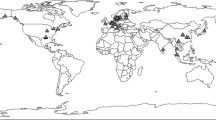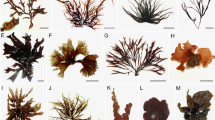Abstract
Members of the family Brachionidae are free-living organisms that range in size from 170 to 250 microns. They comprise part of the zooplankton in freshwater and marine systems worldwide. Morphologically, members of the family are characterized by a single piece loricated body without furrows, grooves, sulci or dorsal head shields, and a malleate trophi. Differences in these structures have been traditionally used to recognize 217 species that are classified into seven genera. However, the validity of the species, Plationus patulus, P. patulus macracanthus P. polyacanthus, and P. felicitas have been confused because they were alternatively assigned in Brachionus or Platyias, when considering only morphological and ecological characters. Based on scanning electron microscope (SEM) images of the trophi, these taxa were assigned in a new genus, Plationus. In this study, we examined the systematic position of P. patulus and P. patulus macracanthus using DNA sequences of two genes: the cytochrome oxidase subunit 1 (cox1) and domains D2 and D3 of the large subunit of the nuclear ribosomal RNA (LSU). In addition, the cox1 and LSU sequences representing five genera of Brachionidae (Anuraeopsis, Brachionus, Keratella, Plationus, and Platyias) plus four species of three families from the order Ploima were used as the outgroup. The maximum likelihood (ML) analyses were conducted for each individual gene as well as for the combined (cox1 + LSU) data set. The ML tree from the combined data set yielded the family Brachionidae as a monophyletic group with weak bootstrap support (<50%). Five main clades in this tree had high (>85%) bootstrap support. The first clade was composed of three populations of P. patulus + P. patulus macracanthus. The second clade was composed of a single species of Platyias. The third clade was composed of six species of Brachionus. The fourth clade included a single species of the genus Anuraeopsis, and the fifth clade was composed of three species of the genus Keratella. The genetic divergence between Plationus and Platyias ranged from 18.4 to 19.2% for cox1, and from 4.5 to 4.9% for LSU, and between Brachionus and Plationus, it ranged from 16.9 to 23.1% (cox1), and from 7.3 to 9.1% (LSU). Morphological evidence, the amount of genetic divergence, the systematic position of Plationus within the family Brachionidae, and the position of Plationus as a sister group of Brachionus and Platyias support the validity of Plationus patulus and P. patulus macracanthus into the genus Plationus.



Similar content being viewed by others
References
Ahlstrom, E. H., 1940. A revision of the Rotatorian genera Brachionus and Platyias with description of one new species and two new varieties. Bulletin of the American Museum of Natural History 77: 143–184.
Bartos, E., 1959. Virníci- Rotatoria. Fauna S R 15, Praha. 969 pp.
Bazinet, A. L. & M. P. Cummings, 2009. The Lattice Project: a Grid research and production environment combining multiple Grid computing models. In Weber W. H. W. (ed.), Distributed & Grid Computing-Science Made Transparent for Everyone Principles, Applications and Supporting Communities Tectum. Marburg: 2–13.
Bazinet, A. L., D. S. Myers, J. Fuetsch & M. P. Cummings, 2007. Grid services base library: a high-level, procedural application program interface for writing Globus-based grid services. Future Generation Computer Systems 23: 517–522.
Ciros-Pérez, J., A. Gómez & M. Serra, 2001. On the taxonomy of the three sympatric sibling species of the Brachionus plicatilis (Rotifera) complex from Spain, with the description of B. ibericus n. sp. Journal of Plankton Research 23: 1311–1328.
Cummings, M. P. & J. C. Huskamp, 2005. Grid computing. Educause Review 40: 116–117.
Cummings, M. P., S. A. Handley, D. S. Myers, D. L. Reed, A. Rokas & K. Winka, 2003. Comparing bootstrap and posterior probability values in the four-taxon case. Systematic Biology 52: 477–487.
Derry, M. A., 2003. Evolution of rotifers in saline and subsaline lakes: a molecular phylogenetic approach. Limnology and Oceanography 48: 675–685.
Drummond, A. J., B. Ashton, M. Cheung, J. Heled, M. Kearse, R. Moir, S. Stones-Havas, T. Thierer & A. Wilson, 2009. Geneious v4.6, Available from http://www.geneious.com/.
Folmer, O., M. Black, W. Hoech, R. Lutz & R. Vrijenhoek, 1994. DNA primers for amplification of mitochondrial cytochrome c oxidase subunit I from diverse metazoan invertebrates. Molecular Marine Biology and Biotechnology 3: 294–299.
García-Varela, M. & S. A. Nadler, 2005. Phylogenetic relationships of Palaeacanthocephala (Acanthocephala) inferred from SSU and LSU rRNA gene sequences. Journal of Parasitology 91: 1401–1409.
Gilbert, J. J. & E. J. Walsh, 2005. Brachionus calyciflorus is a species complex: mating behaviour and genetic differentiation among four geographically isolated strains. Hydrobiologia 546: 257–265.
Gómez, A., 2005. Molecular ecology of rotifers: from population differentiation to speciation. Hydrobiologia 546: 83–99.
Gómez, A., M. Serra, G. R. Carvalho & D. H. Luna, 2002. Speciation in ancient cryptic species complexes: evidence from the molecular phylogeny of Brachionus plicatilis (Rotifera). Evolution 56: 1431–1444.
Gómez, A., J. Montero-Pau, D. H. Lunt, M. Serra & S. Campillo, 2007. Persistent genetic signatures of colonization in Brachionus manjavacas rotifers in the Iberian Peninsula. Molecular Ecology 16: 3228–3240.
Katoh, K., K. Kuma, H. Toh & T. Miyata, 2005. MAFFT version 5: improvement in accuracy of multiple sequence alignment. Nucleic Acids Research 33: 511–518.
Kennari, A. A., N. Ahmadifard & J. Seyfabadi, 2008. Comparison of growth and fatty acids composition of freshwater rotifer, Brachionus calyciflorus Pallas, fed with two types of microalgae at different concentrations. Journal of the World Aquaculture Society 39(2): 235–242.
Koste, W., 1978. Rotatoria in Die Rädertiere Mitteleuropas, Vol 2. Gebrüder Borntraeger, Berlin.
Koste, W. & R. J. Shiel, 1987. Rotifera from Australian inland waters. II. Epiphanidae and Brachionidae (Rotifera: Monogononta). Invertebrate Taxonomy 7: 949–1021.
Kotikova, E. A., O. I. Raikoval, M. Reuter & M. K. S. Gustafsson, 2005. Rotifer nervous system visualized by FMRFamide and 5-H immunocytochemistry and confocal laser scanning microscopy. Hydrobiologia 546: 239–248.
Kutikova, L. A., 1970. Kolovratki fauny SSSR [The rotifer fauna of USSR]. In: Keys of the Fauna of USSR, Vol. 104. 744 pp.
Müller, O. F. 1786., Animacula Infusoria fluviatilia et marina, quae detexit, systematice descripsit et ad vivum delineari curativ sistit opus hoc posthumum quod cum tabulis aenis L. in lucem tradit vidua ejus nobilissima, cura Othonis Fabricii. Hauniae, LVI + 367 pp.
Myers, D. S. & M. P. Cummings, 2003. Necessity is the mother of invention: a simple grid computing system using commodity tools. Journal of Parallel and Distributed Computing 63: 578–589.
Myers, D. S., A. L. Bazinet & M. P. Cummings, 2008. Expanding the reach of Grid computing: combining Globus- and BOINC-based systems. In Talbi, E. G. & A. Zomaya (eds), Grids for Bioinformatics and Computational Biology, Wiley Book Series on Parallel and Distributed Computing. Wiley, New York: 71–85.
Nandini, S., D.de J. Chaparro-Herrera, S. L. Cardenas-Arriola & S. S. S. Sarma, 2007. Population growth of Brachionus macracanthus (Rotifera) in relation to cadmium toxicity: Influence of algal (Chlorella vulgaris) density. Journal of Environmental Science and Health – Part A 42(10): 1467–1472.
Omilian, A. R. & D. J. Taylor, 2001. Rate acceleration and long-branch attraction in a conserved gene of cryptic Daphniid (Crustacea) species. Molecular Biology and Evolution 18: 2201–2212.
Posada, D. & K. A. Crandall, 1998. Modeltest: testing the model of DNA substitution. Bioinformatics 9: 817–818.
Rodríguez, F., J. F. Oliver, A. Marin & J. R. Medina, 1990. The general stochastic model of nucleotide substitution. Journal of Theoretical Biology 142: 817–818.
Rudescu, L., 1960. Rotatoria. Fauna Republici Populare Romine, Trochelminthes, Vol II. Fascicula 2. Acad.Rep. Pop. Romine. 1192 pp (in Rumanian).
Sarma, S. S. S., P. Brena-Bustamante & S. Nandini, 2008. Body size and population growth of Brachionus patulus (Rotifera) in relation to heavy metal (copper and mercury) concentrations. Journal of Environmental Science and Health. Part A, Toxic/Hazardous Substances and Environmental Engineering 43(5): 547–553.
Segers, H., 2002. The nomenclature of the Rotifera: annotated checklist of valid family and genus group names. Journal of Natural History 36: 631–640.
Segers, H., 2007. Annotated checklist of the rotifers (Phylum Rotifera), with notes on nomenclature, taxonomy and distribution. Zootaxa 1546: 1–104.
Segers, H., G. Murugan & H. J. Dumont, 1993. On the taxonomy of the Brachinidae: description of Plationus n. gen. (Rotifera, Monogononta). Hydrobiologia 268: 1–8.
Shimodaira, H. & M. Hasegawa, 1999. Multiple comparisons of log-likelihoods with applications to phylogenetic inference. Molecular Biology and Evolution 16: 1114–1116.
Sorensen, M. V. & G. Giribet, 2006. A modern approach to rotiferan phylogeny: combining morphological and molecular data. Molecular Phylogenetics and Evolution 40: 585–608.
Stelzer, C. P., 2002. Phenotypic plasticity of body size at different temperatures in a planktonic rotifer: mechanisms and adaptive significance. Functional Ecology 16: 835–841.
Suatoni, E., S. Vicario, S. Rice, T. W. Snell & A. Caccone, 2006. Phylogenetic and biogeographic patterns in the salt water rotifer Brachionus plicatilis. Molecular Phylogenetics and Evolution 41: 86–98.
Swofford, D. L., 2000. PAUP*. Phylogenetic analysis using parsimony (*and other methods) version 4.0 Sinauer Associates (eds). Sunderland, Massachusetts.
Sze, S. H., Y. Lu & Q. Yang, 2006. A polynomial time solvable formulation of multiple sequence alignment. Journal of Computational Biology 13: 309–319.
Turner, P., 1940. The rotifer genus Platyias Harring (1913) in the neotropics. Acta Limnologica Brasiliensia 3: 741–756.
Van der Stap, I., M. Vos & W. M. Mooij, 2007. Inducible defenses and rotifer food chain dynamics. Hydrobiologia 593: 103–110.
Wulfert, K., 1965. Revision der Rotatorien-Gattung Platyias Harring 1913. Limnologica 3: 41–64.
Xian-Ling, X., X. Yi-Long & H. Hao-Yuan, 2006. Phylogenetic relationships of Brachionus rotifers based on rDNA ITS 1 gene sequences. Current Zoology (formerly Acta Zoologica Sinica) 52(6): 1067–1074.
Yang, Z., 1994. Estimating the patterns of nucleotides substitution. Journal of Molecular Evolution 39: 105–111.
Zwickl, D. J., 2006. Genetic algorithm approaches for the phylogenetic analysis of large biological sequence datasets under the maximum likelihood criterion. Ph.D. thesis. Texas University, Austin.
Acknowledgments
We thank Patricia de la Torre and Laura Márquez for their technical assistance on the sequencing of the plasmids. We are grateful to A. Bazinet, D. Ayres, and A. Y. Kawahara for their assistance in computational analyses. We are also grateful to S.S.S. Sarma and Nandini, S. for providing specimens of the genus Brachionus for this study. We also thank M. Ortega-Olivares and C. Serranía for their help in the field collection. Reyna-Fabián Miriam offers thanks to the Universidad Nacional Autónoma de México (UNAM) and to the program Doctorado en Ciencias Biomédicas, Instituto de Investigaciones Biomédicas and for the scholarship provided by Consejo Nacional de Ciencia y Tecnología (CONACYT- 203367). This research was supported by the Programa de Apoyo a Proyectos de Investigación e Inovación Tecnológica (PAPIIT No. IN230207), and the Consejo Nacional de Ciencia y Tecnología (CONACYT-No. 61334) to JPL, and PAPIIT-UNAM No. IN215709 and CONACYT-No. 102062 to MGV.
Author information
Authors and Affiliations
Corresponding author
Additional information
Handling editor: K. Martens
Rights and permissions
About this article
Cite this article
Reyna-Fabián, M.E., Laclette, J.P., Cummings, M.P. et al. Validating the systematic position of Plationus Segers, Murugan & Dumont, 1993 (Rotifera: Brachionidae) using sequences of the large subunit of the nuclear ribosomal DNA and of cytochrome C oxidase. Hydrobiologia 644, 361–370 (2010). https://doi.org/10.1007/s10750-010-0203-1
Received:
Revised:
Accepted:
Published:
Issue Date:
DOI: https://doi.org/10.1007/s10750-010-0203-1




